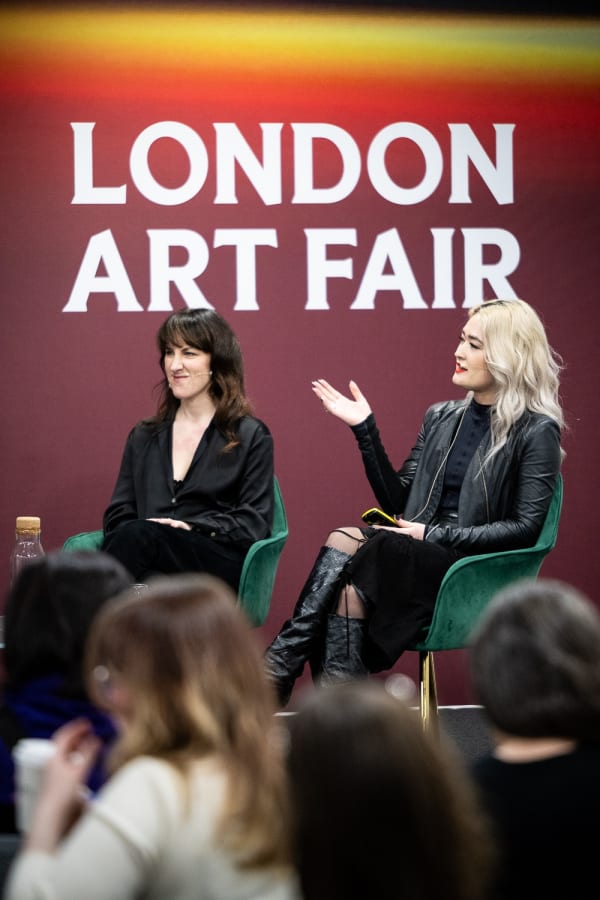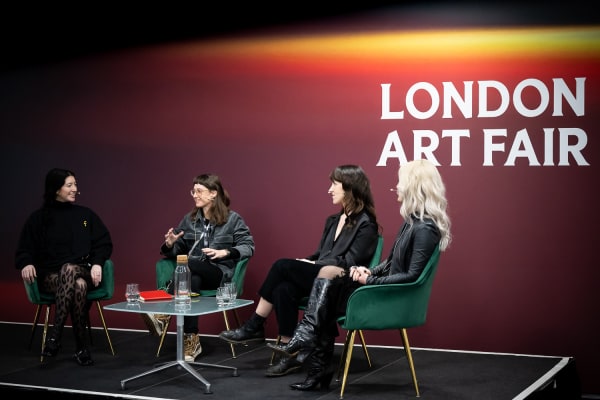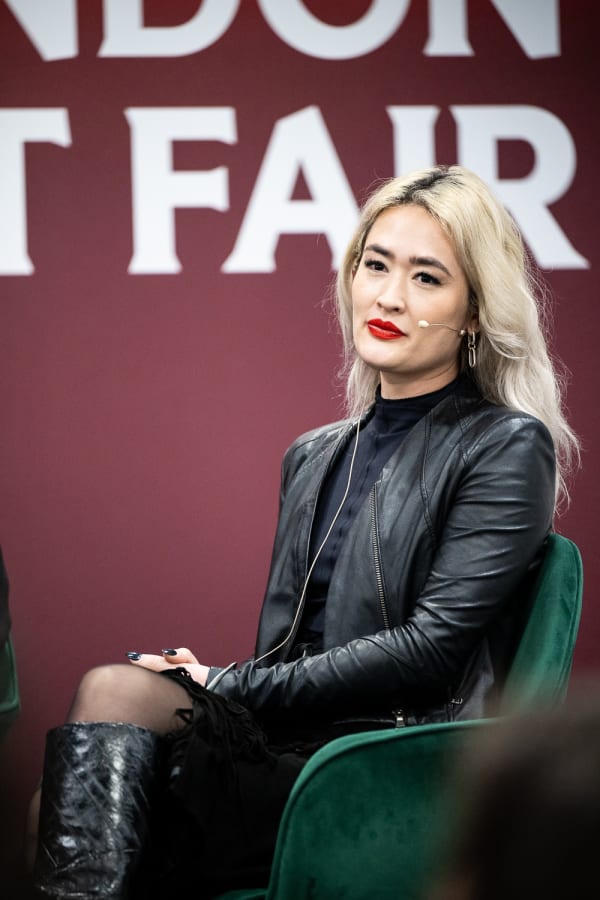Friday 24 January 2025
12 - 1pm Talks Theatre, Business Design Centre, Islington, N1 0QH
Chair
Victoria Comstock-Kershaw – Editor-in-Chief, FETCH London
Panel
Makiko Harris (represented by Maximillian Wolfgang Gallery)
Ana Luiza Rodrigues (represented by Ricardo Fernandes Gallery)
Meryl Donoghue (represented by Cole-Levi Klimt)
The London Art Fair’s Encounters panel explores the concept of dialogue between material, message, and meaning through the works of three female artists: Makiko Harris, Ana Luiza Rodrigues, and Meryl Donoghue.
Meryl Donoghue draws on the architecture of paleontology, blending ancient mythologies with modern scientific practices to construct works that hypostatize traditional narratives of evolution and nature. Ana Luiza Rodrigues juxtaposes natural and industrial elements to interrogate the boundaries between aesthetic beauty and the ordinariness of everyday life, semiotically questioning the ways in which meanings are assigned. Meanwhile, Makiko Harris recontextualises industrial materials as intimate, psychological, and domestic symbols, challenging assumptions about identity, labor, and connection. The overarching narrative woven by Harris, Rodrigues, and Donoghue invites us to reconsider how materials, culture, and personal histories intersect. Exploring themes such as the tension between the organic and the industrial, the personal and the collective, this panel invites audiences to consider how art can mediate encounters between opposing forces, fostering moments of synthesis, tension, and transformation.
Victoria Comstock-Kershaw is an art critic and founder of the “thinking woman’s magazine,” Fetch London. Written by and for intelligent women, Fetch is dedicated to long-form content that critically engages with London’s contemporary arts scene and while offering fresh, incisive perspectives on the city’s cultural landscape. Victoria’s work centers on recontextualising classic art criticism texts and concepts by applying them to contemporary art, with a particular focus on postmodernist and post-internet art writing.
Makiko Harris (b. 1989, She/Her) is an interdisciplinary artist exploring contemporary feminism, identity, desire, and the complex dynamics of spectatorship, voyeurism, and the body. Informed by her experiences as a Japanese American biracial woman, Harris works across painting, installation, sculpture, and sound to examine how labor, value, and culturally dominant assumptions of identity intertwine in a world fragmented by technology. She questions what it means to connect, or be “skintimate,” in an era where touch is often mediated by screens.
Harris’s practice uses the body—especially skin—as both image and commodity, manipulating cropped images of herself into laser-cut steel and oversized, lacquered nails, which embody both the sharp, industrial precision of technology and the intimate vulnerability of flesh. Her delicate, diaphanous paintings of skin highlight the friction between our physical realities and the glossy, artificial images we project and consume. By incorporating symbols like needles, stockings, fingernails, and chains, Harris creates a personal coat of arms, an arsenal that reclaims agency. Inspired by feminist theorists including Rosemary Betterton’s concept of the “monstrous feminine,” Harris constructs a narrative that celebrates the reclamation and subversion of gender stereotypes, offering a powerful portrait of the ambiguities of contemporary femininity.
Harris earned her MA in Contemporary Art Practice from the Royal College of Art, London (2023), and holds a BA in Philosophy and Art from Tufts University, Boston (2011). Selected highlights include ‘Lacquered Rebellion,’ a solo exhibition with Kristin Hjellegjerde Gallery in London (Aug 2024), shortlisted for The Ingram Prize 2024, and ‘Confront and Constrain,’ a group exhibition with Ames Yavuz Gallery in Singapore (Nov 2024). She lives and works between London, UK, and San Francisco, California.
Ana Luiza Rodrigues is a contemporary artist whose multidisciplinary practice spans sculpture, photography, performance and installation. Her work playfully engages with conceptual art and institutional critique, exploring the relationship between aesthetic beauty and the ordinariness of everyday objects. Through her art, Rodrigues challenges notions of fetishism and resilience in daily life, creating empowering yet dissonant narratives that intertwine residual memories with reflections on consumerism and her background in advertising.
Rodrigues earned her MA in Contemporary Photography; Practices and Philosophies with distinction from Central Saint Martins, London in 2019. She also holds a Postgraduate degree in Art History from FAAP, Brazil (2004) and a BA in Advertising and Marketing from Mackenzie University, Brazil (2001).
Recent highlights of her career include Connecting The Dots, an experimental performance presented at the 20th SP-ARTE at Pavilhão da Bienal, São Paulo, Brazil (April 2024); Parole, a solo exhibition at Ricardo Fernandes Gallery, Paris (February 2024); Botanical Convergences, a group exhibition with Luzia Simons in Berlin (January 2024); and Neo Norte 4.0, a group performance in Palermo, Italy (September 2023).
Having recently returned to live and work in London after a period in Hamburg, Germany, Rodrigues continues to push boundaries in contemporary art through her thought-provoking and multifaceted practice.
Meryl Donoghue, born 1984, is a London based multi-disciplinary artist whose work spans a spectrum of media, from highly augmented photographic composites & large-scale cyanotype collages to installations comprising sound, video & animatronics. She has a 1st Class BA(Hons) in Fine Art from Bath Spa University, winning the University Prize upon graduating, and a MA in Fine Art Media from the Slade School in London, where she was awarded the AHRC Block Grant as well as the Julian Sullivan Award for achievements in the field of fine art media. Additionally, she has trained with one of the leading British masters in the art of taxidermy and shadowed established stained-glass artist Jude Stark at her studio in Camberwell.
Meryl has exhibited widely in the UK and internationally earning her critical acclaim. She has most recently completed a solo exhibition ‘On the wheel, atop the pillar, below the ground…’ with KochXBos Gallery in Amsterdam as well as joining a select group of artists at Cole-Levi Klimt for their debut London exhibition ‘Extensions of the Soul’.
Donoghue’s work exists at the intersection of myth, science, and art. Her obsession with materiality and the ancient world has led to a unique practice, combining traditional and contemporary techniques, and offering a fresh perspective on the timeless narratives and social constructs that have shaped our existence. In her renowned ‘The Search for Behemoth’ series, Donoghue reimagines the mythological desert-dwelling creature Behemoth, described to us in the Book of Enoch. Collaborating with her sister, a forensic BSc, they began to construct possible versions of the creature from bones she had collected in the Holy Land. The collected bones were fully scanned from all angles on a flat-bed scanner and then printed as cyan copies. These paper prints were then intricately woven, cut and arranged to create possible ‘blueprints’ of the creature. Beyond these giant collaged blueprints, she also went on to construct a physical version of ‘Behemoth’ using the actual bones, culminating in a sculptural entity that breathes new life into ancient tellings.
Another of her celebrated works, the diptych(s) ‘Bury the Living, Raise the Dead…’, exemplifies Donoghue’s exploration of the themes of life, death, and rebirth. These large scale, collaged cyanotype works combine a use of taxidermy, digital processes and alternative photographic techniques to convey a narrative that speaks to the delicate balance between destruction and healing. These works also pay homage to 19th-century botanist and photographer Anna Atkins, echoing Atkins’ pioneering cyanotypes whilst reinterpreting the process through a contemporary lens. One version of the diptych ‘Bury the Living, Raise the Dead…’ was exhibited at CODA Museum, Netherlands, further showcasing its resonance with international audiences.
- X
- Tumblr



